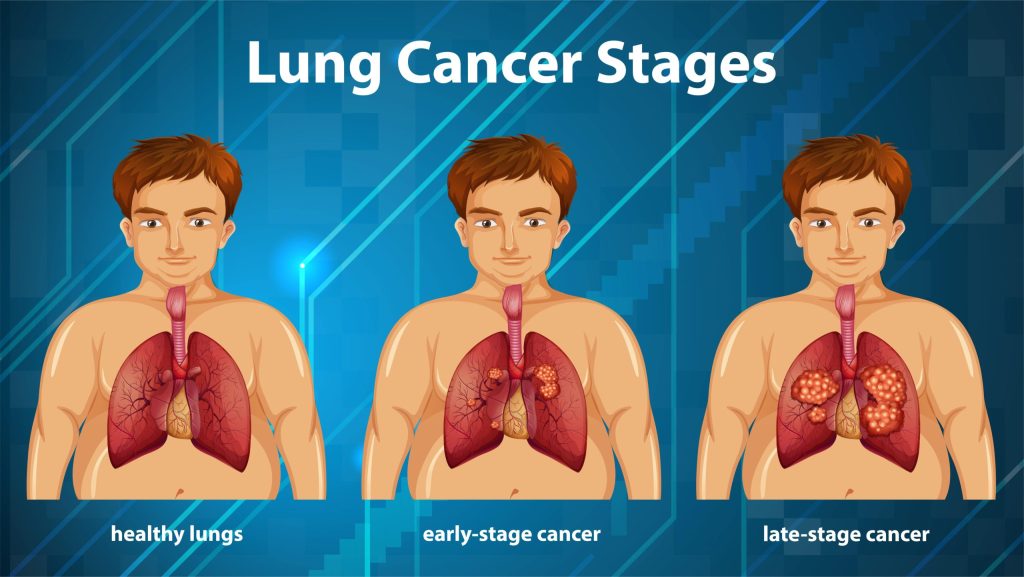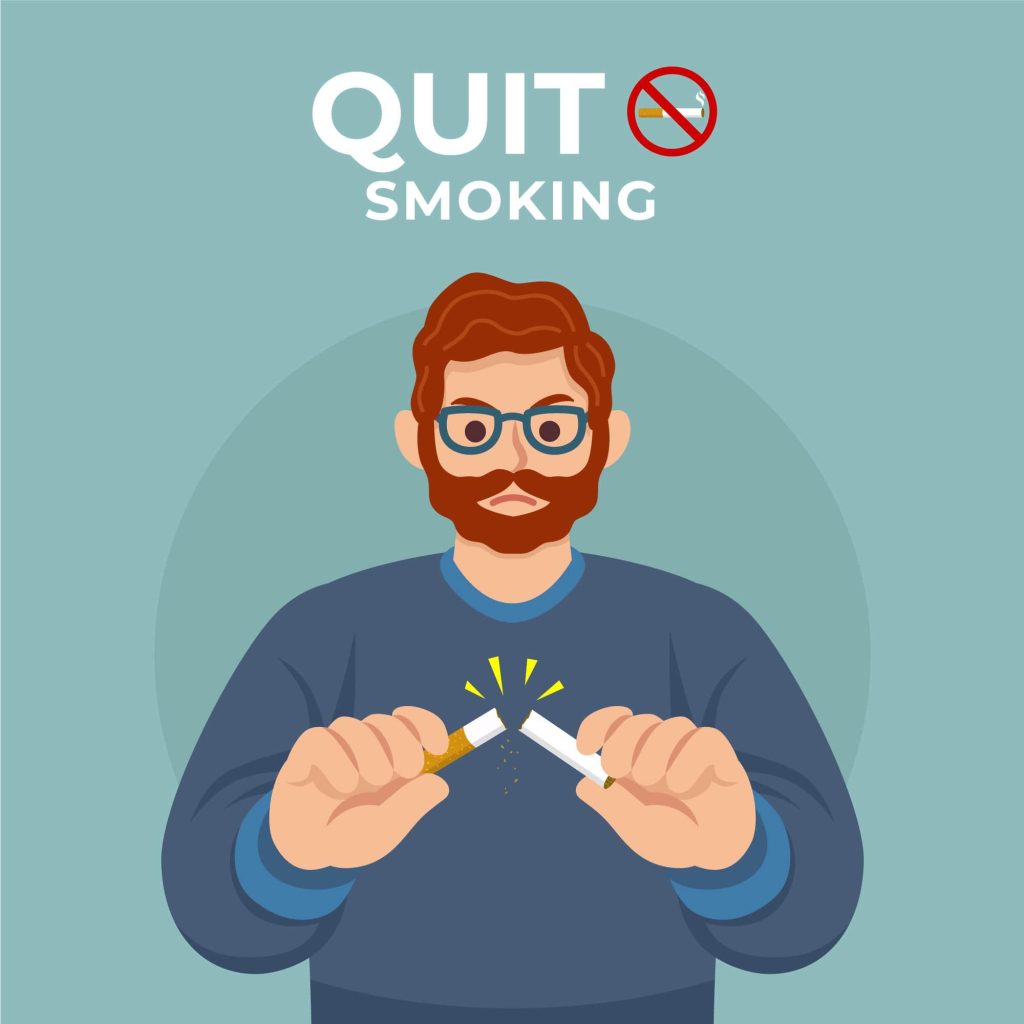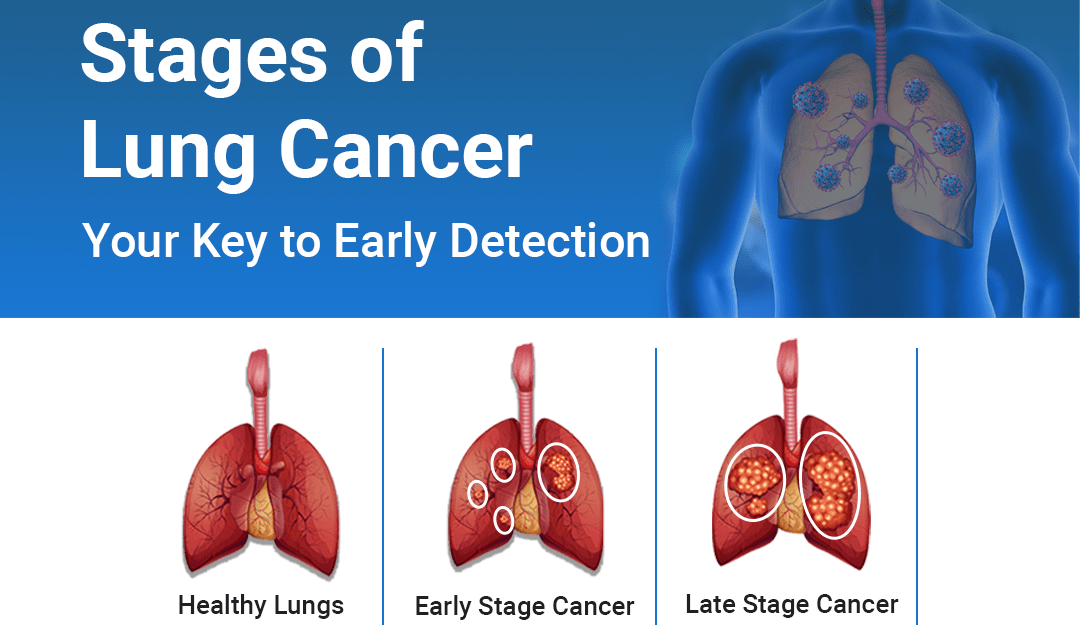Stages of Lung Cancer: Your Key to Early Detection
You’re going well about your daily life, feeling healthy and active when you notice a constant cough or an unusual shortness of breath. You might ignore it as a minor annoyance, hoping it will go away on its own. But what if it doesn’t? What if those subtle signs are your body’s way of giving you a warning?
Lung cancer is a condition, often with no symptoms in its early stages. Understanding the different stages of lung cancer can mean the difference between diagnosing it early and facing a more challenging battle.
In this blog, we’ll learn about the stages of lung cancer. By the end, you’ll be equipped with the information needed to be your health advocate.
Different Stages of Lung Cancer
Before diving into the stages, please note that there are 2 different types of lung cancer, and both the types have different stages.
Non-small cell lung cancer stages

Stage 0- Carcinoma in Situ
Stage 0 is the earliest stage of lung cancer, medically known as “carcinoma in situ.” In this stage, unusual cells are found in the lining of your airways, but they haven’t yet spread beyond that initial layer. The cancer cells are confined to a small area and haven’t overspread to deeper tissues or other parts of your body.
The challenge with stage 0 is that it often doesn’t cause any noticeable symptoms. You may feel healthy and not experience any cough, pain, or breathing difficulties. This is why stage 0 lung cancer is typically discovered incidentally during tests for other unrelated health issues.
While stage 0 might seem less serious compared to later stages of lung cancer, it’s a vital time for intervention. Catching it early gives you the best chance of successful treatment and preventing the cancer from progressing. Early detection can improve your chances of a full recovery. Understanding the different stages of lung cancer, including this early stage, can help you make informed decisions about your treatment options.
Stage I- Localized Lung Cancer
Stage I marks a major point in the stages of lung cancer. This refers to localized lung cancer that has not spread to nearby lymph nodes. While it’s more advanced than stage 0, it’s still considered an early stage with a better outlook for treatment.
Within stage I, there are 2 sub-stages: IA and IB. The difference between these is based on the size of your tumor. In stage IA, the tumor is smaller, usually less than 3 centimeters in diameter. The tumor is larger in stage IB, typically between 3 and 4 centimeters.
Now, here’s the thing about symptoms in stage I lung cancer. Some people don’t experience any symptoms, so regular screenings and check-ups are important. However, others may experience:
- A persistent cough that just won’t go away.
- Shortness of breath during physical activity.
- Wheezing or chest pain.
The above symptoms can be misinterpreted as less serious conditions, like a cold or allergies. That’s why listening to your body and seeking medical attention if you experience any unusual or persistent symptoms is essential. Early detection is critical for the treatment of lung cancer.
Stage II- Locally Advanced Lung Cancer
In stage II lung cancer, the tumor has grown more extensive compared to stage I. It might also have spread to lymph nodes located near the lung. While the cancer hasn’t spread to distant parts of your body yet, it’s still considered locally advanced, meaning it’s progressed beyond the initial site within the lung.
There are two sub-stages within stage II: IIA and IIB. The difference between these is based on both the size of the tumor and whether it has reached nearby lymph nodes. In stage IIA, the tumor might be more prominent than in stage I but hasn’t spread to lymph nodes. In stage IIB, the tumor might be smaller but has spread to nearby lymph nodes.
The symptoms of stage II lung cancer often mirror those of stage I, but they can be more noticeable and intense. So, if you had a cough in stage I, it might become more persistent or produce more phlegm in stage II. Similarly, shortness of breath or chest pain could worsen. In addition, stage II might introduce new symptoms, such as:
- Coughing up blood,
- Feeling fatigued,
- Experiencing hoarseness in your voice.
Understanding these symptoms is crucial, as they can signal the need for prompt medical attention. By recognizing the signs and seeking diagnosis early, you can explore treatment options available for stage II lung cancer and improve your chances of a positive outcome. Remember, knowledge about the stages of lung cancer can help you take control of your health journey.
Stage III- Locally Advanced Lung Cancer
Stage III is where lung cancer takes a more serious turn. In this stage, the tumor has grown larger and spread beyond its initial location within your lung. It might have reached more distant lymph nodes or even nearby structures like the chest wall, diaphragm, or heart.
To understand this stage better, it’s divided into three sub-stages: IIIA, IIIB, and IIIC. These sub-stages reflect the extent to which the cancer has spread. In IIIA, it might have reached lymph nodes on the same side of your chest as the original tumor. In IIIB, it might have spread to lymph nodes on the opposite side of your chest or above the collarbone. IIIC is the most advanced sub-stage within stage III, where cancer has spread to even more distant lymph nodes or structures.
As the cancer progresses in stage III, the symptoms often become more noticeable and severe. You may experience all the symptoms of earlier stages of lung cancer, but they might be more intense and frequent. In addition, stage III may bring about new symptoms:
- Difficulty swallowing
- Unexplained weight loss.
Stage III is a crucial point in the stages of lung cancer, and treatment options can vary depending on the specific sub-stage and overall health.
Stage IV- Metastatic Lung Cancer
Stage IV is the most advanced phase of lung cancer. This means that the cancer cells have moved beyond the lungs and spread to other parts of the body. These areas can include the other lungs, liver, bones, or even the brain.
The symptoms you experience in stage IV can vary relying on where the cancer has spread. You might continue to have the symptoms you experienced in earlier stages of lung cancer. However, new symptoms often emerge as cancer affects other organs.
If the cancer spreads to the bones, you might experience bone pain. If it reaches the brain, you could have headaches, seizures, or dizziness. In cases where the liver is affected, you might notice jaundice. Sometimes, you might also experience swelling in your legs or abdomen.
It’s important to remember that not everyone will experience all these symptoms. The type and severity of symptoms can change based on the individual and where the cancer has spread. It’s crucial to communicate closely with your doctor and discuss any new or worsening symptoms you experience.
While stage IV lung cancer is a severe diagnosis, advancements in treatment continue to offer hope and improve the quality of life for those living with the disease.
Small Cell Lung Cancer
Small cell lung cancer (SCLC) is a different kind that deserves special mention. Unlike the stages of non-small cell lung cancer, we’ve discussed so far, SCLC is categorized into 2 stages:
- Limited
- Extensive
Limited stage SCLC means the cancer is restricted to one side of the chest, within the lung, and nearby lymph nodes. Extensive stage SCLC, on the other hand, indicates that the cancer has spread beyond this area to the other lung, lymph nodes on the opposite side of the chest, or other organs in your body.
While SCLC can share some symptoms with non-small cell lung cancer, such as coughing, shortness of breath, and chest pain, it tends to be a more aggressive form of cancer. This means it can grow and spread rapidly, often leading to earlier and more noticeable symptoms. In addition to the common symptoms, people with SCLC may experience fatigue, hoarseness, difficulty swallowing, and weight loss.
Early detection and treatment are essential for SCLC. If you experience any concerning symptoms, don’t hesitate to consult your doctor for a complete evaluation.
FAQs
How to Prevent Lung Cancer?

Quitting smoking is the most important thing you can do to lower your risk of lung cancer. No matter how long you’ve smoked, quitting can make a big impact. Within 12 years of quitting, your risk of lung cancer drops by more than half, and after 15 years, your risk becomes similar to someone who never smoked. Talk to your doctor or pharmacist for help and support on your journey to quitting.
A balanced diet, including vegetables, whole grains, and fruits, reduces your risk. Aim for at least five portions of fruits and vegetables daily, accompanied by fiber-rich whole grains.
Regular workouts can also play a role in lowering your lung cancer risk, especially if you currently smoke or have smoked in the past. Staying active may even help reduce symptoms like fatigue and anxiety if you already have lung cancer.
Which is the most common lung cancer in smokers?
Non-small cell lung cancer is the most common type of lung cancer, making up the majority of cases. Research shows a strong link between smoking and lung cancer, with tobacco use being a major factor contributing to the development of this disease.
Is lung cancer curable?
In some cases, if lung cancer is found and treated before it spreads, it’s possible to fully recover. However, doctors usually don’t use the word “cured” when talking about cancer. Instead, they might say the cancer is in “remission” or that there’s “no evidence of disease” (NED). If you remain in remission or NED for a long time, typically five years or more, the chances of the cancer coming back are much lower, and you might be considered cured.
Can you get lung cancer without smoking?
Even if you don’t smoke, you’re still at risk for lung cancer if you’re around people who do. Secondhand smoke is dangerous and can harm your lungs.
Another risk factor work related exposure to things like asbestos, chemicals, etc.
What is second hand smoke and how it can lead to lung cancer?
Secondhand smoke is harmful, mainly for kids. The ideal way to protect loved ones is to quit smoking. When you smoke, the smoke goes into the air, where others can breathe it. Secondhand smoke can cause health issues like lung cancer and heart disease for those regularly exposed.
Conclusion
Understanding the different stages of lung cancer is crucial for early detection and effective treatment.
Don’t hesitate to ask questions, seek support, and advocate for your health.
Ready to take the next step in prioritizing your lung health? Don’t wait. Register for free and book an appointment with a healthcare professional today on Cellmaflex.

